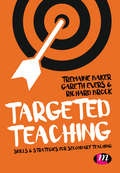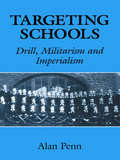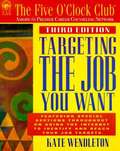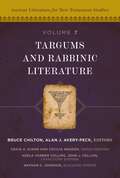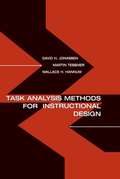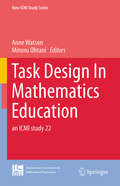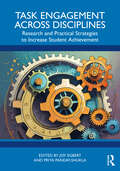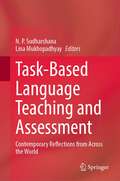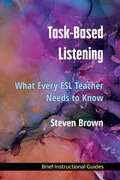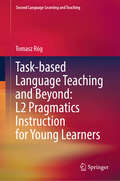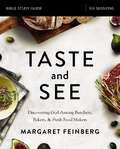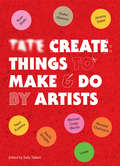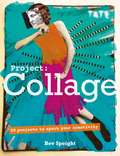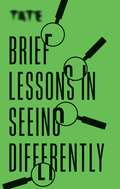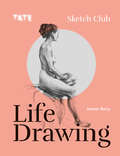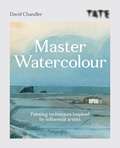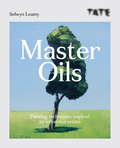- Table View
- List View
Targeted Teaching: Strategies for secondary teaching
by Tremaine Baker Gareth Evers Richard BrockThere is no single best approach in teaching. This new text challenges the idea that there is a 'best way' to teach. Instead, the authors explain, a more pragmatic approach is required. Teachers need a range of skills and strategies to select from, work with and adapt. Every school, cohort, class and child is different. Beyond that, strategies that worked well with a class one week, may prove ineffective the next. This book: presents a range of strategies, well grounded in research, for trainees and beginning teachers to use in their own classroom settings and contexts presents a model of teaching that views teaching not as a profession in which there is always a single correct answer, but as a complex interaction between teacher and students addresses common issues that beginning teachers face when developing their practice If you are a teacher wanting to find out what works best for your class, in your school, right now, this text will show you how to harness the power of small or large scale research to help you find the answer.
Targeted Teaching: Strategies for secondary teaching
by Tremaine Baker Gareth Evers Richard BrockThere is no single best approach in teaching. This new text challenges the idea that there is a ′best way′ to teach. Instead, the authors explain, a more pragmatic approach is required. Teachers need a range of skills and strategies to select from, work with and adapt. Every school, cohort, class and child is different. Beyond that, strategies that worked well with a class one week, may prove ineffective the next. This book: presents a range of strategies, well grounded in research, for trainees and beginning teachers to use in their own classroom settings and contexts presents a model of teaching that views teaching not as a profession in which there is always a single correct answer, but as a complex interaction between teacher and students addresses common issues that beginning teachers face when developing their practice If you are a teacher wanting to find out what works best for your class, in your school, right now, this text will show you how to harness the power of small or large scale research to help you find the answer.
Targeting Schools: Drill, Militarism and Imperialism
by Alan PennMilitarism was inseparable from imperialism in Britain, as in other imperialist nations, and its proponents saw schools as ideal means by which to give the nation's youth an early introduction to military drill. This book traces the history of military drill for pupils in elementary schools from 1870-1914.
Targeting the Job You Want (Five O'Clock Club Series)
by Kate WendletonThe best book on the market to help you figure out who you are, what you enjoy doing, and what you want to do with your life. Landing the job of your dreams means you need to have a dream to begin with. TARGETING THE JOB YOU WANT helps you Identify that dream... make it specific... and figure out step by step how you can achieve it.
Targums and Rabbinic Literature (Ancient Literature for New Testament Studies)
by ZondervanAncient Literature for New Testament Studies is a multivolume series that seeks to introduce key ancient texts that form the cultural, historical, and literary context for the study of the New Testament.Each volume will feature introductory essays to the corpus, followed by articles on the relevant texts. Each article will address introductory matters, provenance, summary of content, interpretive issues, key passages for New Testament studies and their significance.Neither too technical to be used by students nor too thin on interpretive information to be useful for serious study of the New Testament, this series provides a much-needed resource for understanding the New Testament in its first-century Jewish and Greco-Roman context. Produced by an international team of leading experts in each corpus, Ancient Literature for New Testament Studies stands to become the standard resource for both scholars and students.Volumes include:Apocrypha and the SeptuagintOld Testament PseudepigraphaThe Dead Sea ScrollsThe Apostolic FathersPhilo and JosephusGreco-Roman LiteratureTargums and Early Rabbinic LiteratureGnostic LiteratureNew Testament Apocrypha and Pseudepigrapha
Tarka Saastram, Intermediate First Year, Telugu Medium - Telangana Board
by Prof. R.Venkata Reddy Prof. S. Abdul Sattar Prof. K. Chenchu lakshmi Dr C. H. Vamshidhar T. SusheelaThis is the text book prescribed for Logic to the Telugu Medium students of Intermediate First Year in Telangana.
Task Analysis Methods for Instructional Design
by David H. Jonassen Martin Tessmer Wallace H. HannumTask Analysis Methods for Instructional Design is a handbook of task analysis and knowledge elicitation methods that can be used for designing direct instruction, performance support, and learner-centered learning environments. To design any kind of instruction, it is necessary to articulate a model of how learners should think and perform. This book provides descriptions and examples of five different kinds of task analysis methods: *job/behavioral analysis; *learning analysis; *cognitive task analysis; *activity-based analysis methods; and *subject matter analysis. Chapters follow a standard format making them useful for reference, instruction, or performance support.
Task Design In Mathematics Education
by Anne Watson Minoru OhtaniThis book is the product of ICMI Study 22 Task Design in Mathematics Education. The study offers a state-of-the-art summary of relevant research and goes beyond that to develop new insights and new areas of knowledge and study about task design. The authors represent a wide range of countries and cultures and are leading researchers, teachers and designers. In particular, the authors develop explicit understandings of the opportunities and difficulties involved in designing and implementing tasks and of the interfaces between the teaching, researching and designing roles - recognising that these might be undertaken by the same person or by completely separate teams. Tasks generate the activity through which learners meet mathematical concepts, ideas, strategies and learn to use and develop mathematical thinking and modes of enquiry. Teaching includes the selection, modification, design, sequencing, installation, observation and evaluation of tasks. The book illustrates how task design is core to effective teaching, whether the task is a complex, extended, investigation or a small part of a lesson; whether it is part of a curriculum system, such as a textbook, or promotes free standing activity; whether the task comes from published source or is devised by the teacher or the student.
Task Design In Mathematics Education: an ICMI study 22 (New ICMI Study Series #17)
by Anne Watson Minoru Ohtani*THIS BOOK WILL SOON BECOME AVAILABLE AS OPEN ACCESS BOOK*This open access book is the product of ICMI Study 22 Task Design in Mathematics Education. The study offers a state-of-the-art summary of relevant research and goes beyond that to develop new insights and new areas of knowledge and study about task design. The authors represent a wide range of countries and cultures and are leading researchers, teachers and designers. In particular, the authors develop explicit understandings of the opportunities and difficulties involved in designing and implementing tasks and of the interfaces between the teaching, researching and designing roles – recognising that these might be undertaken by the same person or by completely separate teams. Tasks generate the activity through which learners meet mathematical concepts, ideas, strategies and learn to use and develop mathematical thinking and modes of enquiry. Teaching includes the selection, modification, design, sequencing, installation, observation and evaluation of tasks. The book illustrates how task design is core to effective teaching, whether the task is a complex, extended, investigation or a small part of a lesson; whether it is part of a curriculum system, such as a textbook, or promotes free standing activity; whether the task comes from published source or is devised by the teacher or the student.
Task Engagement Across Disciplines: Research and Practical Strategies to Increase Student Achievement
by Joy Egbert Priya Panday-ShuklaUsing an evidence-based model developed by Egbert and colleagues, editors Joy Egbert and Priya Panday-Shukla provide a comprehensive overview of task engagement for teachers and researchers. Research has positioned task engagement as central to student learning, and Egbert and Panday-Shukla now collate this research into a resource that teachers can utilize. The chapters address how task engagement theory, evidence, and instruction can be applied to increase learner achievement. The editors and contributors draw from backgrounds across science, technology, engineering, art, and math (STEAM) education and other disciplines to present task engagement and connect its importance to the success of today’s students. Chapters include background information, resources, exercises, and ideas for teachers and researchers to extend the research behind individual elements of the task engagement model into practice. Each chapter focuses on one component of the model and includes guiding questions and key points, a “how-to” section, and recommended tasks for K-adult classroom use. Though ideal for teacher education research scholars, students, and faculty, this book is useful for instructors at all levels interested in integrating task engagement principles into their practice.
Task-Based Language Teaching and Assessment: Contemporary Reflections from Across the World
by N. P. Sudharshana Lina MukhopadhyayThis book provides interdisciplinary perspectives on task-based language teaching (TBLT) and task-based language assessment (TBLA) in English as a second language (ESL) context. It discusses theoretical and experimental insights of TBLT and TBLA from cognitive, cognitive linguistic, and psycholinguistic viewpoints. The chapters, written by leading language teaching specialists in the field, introduce the reader to a comprehensive range of issues related to TBLT and TBLA such as curriculum design, materials development, and classroom teaching & testing. With interdisciplinary appeal, the book is a valuable resource for researchers in task-based language teaching and assessment. It is equally useful for teachers to whom it offers practical suggestions for designing tasks for teaching and testing.
Task-Based Listening (Kindle Single): What Every ESL Teacher Needs to Know
by Steven Brown“I have tried to balance classroom advice with the reasons for the advice, grounded in research evidence. I think it’s important--if you want to grow as a teacher--that you have not only a bag of tricks, but a base from which to discuss your classroom with other teachers.” – Steven Brown This e-single is an introduction to task-based listening for ESL/EFL teachers who are looking for ways to do more in their listening classes than ask students to answer comprehension questions about something they listened to. In this short ebook, Steven Brown, author of Listening Myths: Applying Second Language Research to Classroom Teaching and a well-known ESL/EFL listening textbook series, defines task-based listening (TBL) and describes: how to build a task-based listening program how to create a task-based listening lesson ways to activate vocabulary acquisition in listening tasks how listening can improve grammatical knowledge the links between listening and pronunciation the ways that metacognitive strategies can assist students when listening, particularly when listening to lectures the advantages of extensive listening (especially while reading) the benefits of interactive listening, including how to design a good speaking task All chapters include specific tips and suggestions for using these concepts in the classroom.
Task-Based Listening: What Every ESL Teacher Needs to Know
by Steven BrownAre you looking for activities to use in your listening classes beyond asking students to answer comprehension questions? In Task-Based Listening, author Steven Brown defines task-based listening (TBL) and describes how to build a task-based listening program, how to create a task-based listening lesson, ways to activate vocabulary acquisition and improve grammatical knowledge, and the links between listening and pronunciation. In addition, he covers the ways that metacognitive strategies can assist students when listening, the advantages of extensive listening, and the benefits of interactive listening. Readers will find specific tips and suggestions for using these concepts in the classroom.
Task-based Language Teaching and Beyond: L2 Pragmatics Instruction for Young Learners (Second Language Learning and Teaching)
by Tomasz RógThis book provides a groundbreaking exploration of how task-based language teaching (TBLT) can effectively develop second language (L2) pragmatic competence in young learners. Bridging the gap between TBLT and L2 pragmatics, this volume addresses critical issues in language education, offering insights into teaching key speech acts. Specifically, it compares the outcomes of TBLT with the traditional PPP framework in teaching L2 speech acts to Polish learners of L2 English aged 8 to 9. Chapter 1 deals with pragmatics and pragmatic competence, highlighting its importance in effective communication and language use in social contexts. It addresses L2 pragmatics, the development of L2 pragmatic competence, and the challenges in teaching and assessing this competence. Chapter 2 overviews TBLT, its theoretical foundations, practical implementation, and related empirical research. It discusses the cognitive-interactionist and sociocultural perspectives on L2 acquisition and the effectiveness of tasks. Chapter 3 reviews empirical research on using tasks in teaching L2 pragmatics, especially to young learners. Chapter 4 details the research methodology used in the study, including the context, participants, target speech acts, data elicitation instruments, and analysis procedures. Chapter 5 presents the results of the study. Chapter 6 discusses the findings, their pedagogical implications, and the limitations of the study. Chapter 7 offers conclusions. Rich with pedagogical implications, the volume is an essential resource for researchers and practitioners interested in task-based and task-supported teaching, L2 pragmatics, and innovative approaches to teaching young learners.
Taste and See Bible Study Guide: Discovering God among Butchers, Bakers, and Fresh Food Makers
by Margaret FeinbergYou're invited on a delectable pilgrimage to discover the secret to savoring every day.The Psalmist declared, "Taste and see that the Lord is good" (Ps 34:8), so Margaret Feinberg, one of America's most beloved Bible teachers, took the invitation literally.She embarked on a culinary and spiritual adventure that took her far and wide: descending 410 feet into a salt mine, baking fresh matzo at Yale University, harvesting olives off the Croatian coast, and tasting succulent figs at a premier farm--all to discover the truth of God&’s goodness.With each person she encountered, she asked, "How do you read the Scripture in light of what you do every day?"Their answers will change the way you read the Bible forever... and the way you approach every meal."This is a journey that changed my life, my faith, my future," she writes. "It moved me from fear and uncertainty to discover a renewed, vibrant faith again--and I believe it will do the same for you."With her delightful curiosity and humor, you'll learn to:• Overcome awkwardness and nurture deeper connections around any table.• Rise above uncertainty, knowing what seeds God has planted in you.• Learn how you were uniquely created to help others flourish.• Unlock the satisfying and fruitful life you've been created for.• Last, but not least, you&’ll learn how to make some delicious meals along the way!Join Margaret in this deeply nourishing six-week video Bible study sprinkled with step-by-step recipes and biblical insights. After all, it's at the table where we learn to taste and see the goodness of God.Sessions include:1. You're Invited to the Table – Making deeper connections around any table.2. Delighting in the Sweetness of Fruitfulness – A closer look at the imagery of fruit in the Bible.3. Chewing on the Bread of Life – More than a biblical metaphor! Professional bakers respond.4. Savoring the Salt of the Earth – How many different kinds of salt can you think of? 5. Relishing the Olive and Its Oil – Why the olive leaf is a miracle of creation. 6. Discovering the Liturgy of the Table – Experience God&’s goodness in community. Designed for use with the Taste and See Video Study (9780310087847), sold separately.
Tate Create Things to Make & Do (Tate #11)
by Sally TallantCut, cook, draw, dye, dream, snap and spin!Who better to make art with than today's best-loved artists? This absorbing book has been created by a selection of the world's leading contemporary artists and provides projects and activities designed to challenge and expand your approach to making art. You will never again find yourself short of ideas for things to make and do!Make recipes by Olafur Eliasson and listen to how they sound; create a spotty, squirmy salamander with Monster Chetwynd; trace meditative drawings and explore the power of repetition with Yayoi Kusama; build a living collage with Linder; or get stuck into some classic puzzle activities turned on their heads by Jeremy Deller. Each activity draws on the artist's own practice and is supported by guidance and advice from the artists themselves.
Tate: 50 Projects To Spark Your Creativity (Tate #1)
by Bev SpeightCut it, stick it, twist it! Collage is the art of reinvention, a magical and tactile process that invites you to collect, experiment, combine and transform. Requiring no specialist equipment - only everyday materials - it is an art form for everyone and every budget. From striking architectural builds to mixed-media menageries, this book offers fresh ideas and guidance to help you cut and paste your way to your own unique artworks.
Tate: Brief Lessons in Seeing Differently
by Frances Ambler'the mundane becomes special as soon as you pay attention to it' - Susan HillerThis essential guide delves into the techniques, routines and mindsets of boundary-shifting artists, and the ways in which seeing differently can lead to creating something original. Learn the advantages of a different angle with Georges Braque, view everyday sights in a new way with Alex Katz and open your eyes to the possibilities of colour with Josef Albers. In every chapter, inspiring anecdotes and practical exercises will you help you gain a new perspective and reinvigorate your work.
Tate: Brief Lessons in Seeing Differently (Tate #12)
by Frances Ambler'the mundane becomes special as soon as you pay attention to it' - Susan HillerThis essential guide delves into the techniques, routines and mindsets of boundary-shifting artists, and the ways in which seeing differently can lead to creating something original. Learn the advantages of a different angle with Georges Braque, view everyday sights in a new way with Alex Katz and open your eyes to the possibilities of colour with Josef Albers. In every chapter, inspiring anecdotes and practical exercises will you help you gain a new perspective and reinvigorate your work.
Tate: Life Drawing (Tate #3)
by Hester BerryLearn how to construct a figure, capture gesture and bring depth, energy and movement into your work with the expert guidance of Sketch Club: Life Drawing. Featuring 20 step-by-step exercises, this book will give you the confidence to ace your human figure drawing skills, both inside and outside the studio. It will help you know where to start, when to stop and how to fix common mistakes. Hone your skills, build your confidence, and most importantly, get drawing!
Tate: Life Drawing (Tate Ser.)
by Hester BerryThe only way to get better at drawing is through practise - and there is no better subject to draw from than life. Let Sketch Club: Life Drawing show you how.This practical guide to capturing the human figure teaches fundamental drawing skills while providing instruction on how to get the most from a life drawing class.Featuring 20 step-by-step exercises, the book shows intermediate artists how to put their skills into practice. Learn how to construct a figure, capture gesture and bring depth, energy and movement into your work. Sketch Club: Life Drawing is the first in an exciting new series aimed at demystifying the artist's process. The book covers a range of media and offers inspirational references to the work of other famous artists. A problem-solving section covers how to fix common mistakes and know when to stop. Hone your skills, build your confidence, and most importantly, get drawing!
Tate: Painting techniques inspired by influential artists
by David ChandlerArtists & Illustrators magazine's Book of the Month Taking inspiration from iconic paintings in the Tate collection, discover the techniques of the masters and improve your own painting skills with 30 guided projects. As you work through the exercises, you'll learn how to work 'wet into wet' with Maggi Hambling, master colour temperature with John Singer Sargent and create rhythm and unity in your paintings with John Nash.Whether you are looking to reinvigorate your watercolour practice with new techniques, try your hand at a wide variety of painting styles, or discover a new, inspiring master of the art, this book offers something new for every watercolourist.
Tate: Painting techniques inspired by influential artists
by Selwyn LeamyLearn how to paint in the fantastic medium of oil. Taking inspiration from iconic paintings in the Tate Collection, discover the techniques of the masters and improve your own painting skills with 30 guided projects. Master brushwork and form with Cézanne; thin and blend with Turner and Whistler; and play with texture with Richter and Riley.
Tate: Painting techniques inspired by influential artists (Tate #13)
by David ChandlerArtists & Illustrators magazine's Book of the Month Taking inspiration from iconic paintings in the Tate collection, discover the techniques of the masters and improve your own painting skills with 30 guided projects. As you work through the exercises, you'll learn how to work 'wet into wet' with Maggi Hambling, master colour temperature with John Singer Sargent and create rhythm and unity in your paintings with John Nash.Whether you are looking to reinvigorate your watercolour practice with new techniques, try your hand at a wide variety of painting styles, or discover a new, inspiring master of the art, this book offers something new for every watercolourist.
Tate: Painting techniques inspired by influential artists (Tate #2)
by Selwyn LeamyLearn how to paint in the fantastic medium of oil. Taking inspiration from iconic paintings in the Tate Collection, discover the techniques of the masters and improve your own painting skills with 30 guided projects. Master brushwork and form with Cézanne; thin and blend with Turner and Whistler; and play with texture with Richter and Riley.
